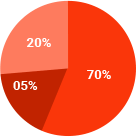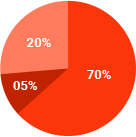
Investment Planning
Why investment planning is important in website design & development
Investment planning is a vital aspect of website design and development, as it enables businesses to create a website that aligns with their financial goals and objectives.
- Socially Responsible Investment
- Comprehensive Investment Plans
- Financial Planning for Business
- Tax Mitigation Strategies



Here are some reasons why investment planning is important in website design and development:
- Aligns with Financial Goals: Investment planning helps businesses identify the right investments to achieve their financial goals, whether it’s increasing revenue, reducing costs, or improving customer engagement. A well-planned website design and development project can help businesses achieve these goals by providing a solid foundation for their online presence.
- Ensures Return on Investment (ROI): Investment planning ensures that the website design and development project yields a positive ROI. By identifying the right investments, businesses can minimize waste and maximize returns, making their website a valuable asset for their organization.
- Fosters Long-Term Growth: A well-planned website design and development project can help businesses adapt to changing market trends and customer needs, ensuring long-term growth and success. Investment planning helps businesses identify areas for future development and integration, allowing them to stay ahead of the competition.
- Socially Responsible Investment
- Comprehensive Investment Plans
- Financial Planning for Business
- Tax Mitigation Strategies

The financial flow of website design and development involves several stages, from planning to launch. Here’s a breakdown of the key steps:
- Pre-Design Phase:
- Planning and research: Define the project scope, target audience, and goals.
- Budgeting: Determine the budget for the project.
- Team assembly: Assemble a team of designers, developers, and project managers.
- Design Phase:
- Sitemap creation: Create a visual representation of the website’s structure and hierarchy.
- Wireframing: Create low-fidelity designs to visualize the website’s layout and user flow.
- High-fidelity design: Create detailed, high-quality designs for the website.
- Development Phase:
- Front-end development: Build the website’s user interface and user experience using HTML, CSS, and JavaScript.
- Back-end development: Develop the website’s server-side logic, database integration, and API connectivity.
- Testing and quality assurance: Test the website for bugs, compatibility, and performance.
- Launch Phase:
- Testing and quality assurance: Conduct thorough testing to ensure the website is bug-free and functional.
- Launch preparation: Prepare the website for launch by configuring hosting, setting up analytics, and configuring SEO.
- Launch: Launch the website and make it live for the public.
- Post-Launch Phase:
- Maintenance and updates: Regularly update and maintain the website to ensure it remains secure, fast, and functional.
- Analytics and reporting: Monitor website performance and analytics to identify areas for improvement.
- Content creation: Create and publish new content to keep the website fresh and engaging.
Financial Considerations
- Budgeting: Determine the budget for the project and allocate resources accordingly.
- Cost estimation: Estimate the cost of each stage of the project, including design, development, testing, and launch.
- Payment schedules: Establish a payment schedule for the project, including milestones and deadlines.
- Return on investment (ROI): Monitor the website’s ROI and adjust the financial flow accordingly to optimize performance.
Website design and development companies play a crucial role in helping businesses establish a strong online presence. To achieve growth, these companies must focus on delivering high-quality services, building strong relationships with clients, and staying up-to-date with the latest industry trends.
Key Factors Affecting Growth:
- Customized Solutions: Providing tailored solutions to meet clients’ unique needs is essential for growth. Companies that focus on delivering customized solutions can attract and retain clients more effectively.
- Expertise: Having a team of experienced web designers, developers, and strategists is vital for delivering high-quality services. Companies that invest in their employees’ skills and knowledge can stay ahead of the competition.
- Client Focus: Building strong relationships with clients is critical for growth. Companies that prioritize client satisfaction and provide excellent customer service can generate positive word-of-mouth and referrals.
- Innovation: Staying up-to-date with the latest industry trends and technologies is essential for growth. Companies that innovate and adapt quickly can differentiate themselves from competitors.
- Data-Driven Approach: Using data to inform design and development decisions can help companies optimize their services and improve client outcomes.
Strategies for Growth:
- Growth-Driven Design: This approach involves developing a website that is designed to grow and evolve over time. By using data to inform design decisions, companies can create websites that drive business growth.
- Agile Development: Agile development methodologies can help companies deliver high-quality services quickly and efficiently. By breaking down projects into smaller, manageable tasks, companies can respond to changing client needs and priorities.
- Content Creation: Creating high-quality content can help companies attract and engage with clients. By developing a content strategy that aligns with their target audience’s needs, companies can establish themselves as thought leaders in their industry.
- Partnerships and Collaborations: Building partnerships and collaborations with other companies can help companies expand their reach and capabilities. By working together, companies can share knowledge, resources, and expertise to deliver high-quality services.
- Investment in Technology: Investing in the latest technologies and tools can help companies streamline their processes, improve efficiency, and deliver high-quality services. By staying up-to-date with the latest technologies, companies can stay ahead of the competition.
Why Invest in Website Design and Development?
- Attract and engage customers: A website is often the first point of contact between a business and its customers. A well-designed website can help attract and engage customers, increasing the chances of converting them into paying clients.
- Increase conversions: A user-friendly and intuitive website can help increase conversions by making it easy for customers to find what they’re looking for and complete a purchase or take a desired action.
- Improve brand visibility: A professional-looking website can help improve a business’s brand visibility, establishing credibility and trust with potential customers.
- Stay competitive: In today’s digital age, having a website is no longer a luxury, but a necessity. Investing in website design and development can help a business stay competitive and ahead of the competition.
Costs and Benefits
- The cost of website design and development can vary depending on the scope of the project, the complexity of the design, and the technology used. However, the benefits of investing in a website can far outweigh the costs.
- A well-designed and developed website can increase conversions, drive revenue, and improve brand visibility, ultimately leading to a positive return on investment (ROI).

